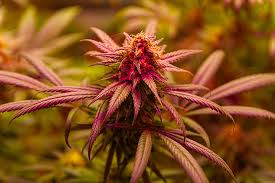News & Events
Exploring the Unique Qualities of the Mexican Red Hair Strain 0
- August 1, 2025
- Posted by: Durratul Jinaan Daties S.Hut
- Category: kindseed

The mexican red hair strain is a fascinating variety of cannabis that captures the attention of both seasoned cultivators and novice growers alike. This strain is celebrated not only for its distinctive appearance featuring vibrant red and orange hairs but also for its unique cannabinoid profile and effects. This article will delve into the origins, cultivation, flavor profile, and medicinal benefits of the Mexican Red Hair strain, providing insights for anyone interested in this intriguing cannabis variety.
Origins and History
The Mexican Red Hair strain has deep roots in the rich tradition of cannabis cultivation that dates back centuries in Mexico. It is believed to be a descendant of Native Mexican landrace strains, which have been selectively bred by indigenous communities for their psychoactive properties and resilience in various growing conditions. Over time, these genetics have been adapted and modified, resulting in the modern Mexican Red Hair strain known today.
Growth Characteristics
For growers looking to cultivate the Mexican Red Hair strain, it is essential to understand its growth characteristics. Typically, this strain thrives in warmer climates, drawing on its origins from the sun-kissed Mexican hills. The plants generally exhibit strong growth and resilience, making them suitable for both indoor and outdoor cultivation.
Indoors, the Mexican Red Hair plants can reach moderate heights, often requiring some training techniques such as topping or low-stress training (LST) to maximize yield. Outdoors, these plants flourish in direct sunlight, showcasing their vibrant colors and robust structure, with the right conditions leading to bountiful harvests.
Flowering Time and Yield
The flowering time for the Mexican Red Hair strain generally falls within the 8 to 10 weeks range, depending on the specific phenotype and growing conditions. Growers can expect a moderate yield, with close attention to nutrient management and environmental factors playing a significant role in the outcome.
Flavor Profile
One of the standout features of the Mexican Red Hair strain is its rich and robust flavor profile. Upon inhalation, users often describe a complex blend of earthy, sweet, and spicy notes that evoke the essence of its Mexican heritage. The smoke is smooth, and when cultivated properly, it produces a delectable experience that lingers on the palate.
Connoisseurs may also note hints of citrus and herbal undertones, adding to the strain’s unique appeal. This multifaceted flavor profile makes the Mexican Red Hair strain a pleasure to enjoy, whether in a joint, a vaporizer, or an edible format.

Effects and Potency
The effects of the Mexican Red Hair strain are well-balanced, providing users with both mental stimulation and relaxation. The strain is typically associated with moderate to high THC levels, which contribute to its psychoactive effects. Users often report feelings of euphoria, creativity, and sociability, making it an excellent choice for social gatherings or artistic endeavors.
While the uplifting effects can enhance mood and promote creativity, the strain also delivers a calming body high that helps to relieve stress and tension. For this reason, the Mexican Red Hair strain has become a popular choice for those seeking both recreational and therapeutic benefits.
Medicinal Benefits
In addition to its recreational appeal, the Mexican Red Hair strain also offers numerous medicinal benefits. Many users turn to this strain for its potential to alleviate symptoms associated with various physical and mental health conditions. Its uplifting effects may help combat anxiety, depression, and stress-related disorders, making it a go-to for individuals seeking a natural way to enhance their mental well-being.
Moreover, the calming body high can assist with pain management, muscle tension, and insomnia, providing relief to those experiencing chronic pain or sleep disturbances. The balanced nature of the strain makes it a versatile option for both novice and experienced users looking for therapeutic relief.
Cultivation Tips
For those eager to grow the Mexican Red Hair strain, here are some essential cultivation tips to maximize success:
- Climate: Ensure a warm climate with plenty of sunlight for outdoor cultivation.
- Nutrient Management: Monitor soil nutrients and adjust feeding schedules to promote healthy growth.
- Pruning: Regularly prune plants to improve air circulation and light penetration.
- Watering: Water consistently but avoid overwatering to prevent root rot.
Conclusion
The Mexican Red Hair strain stands out in the cannabis world for its unique combination of vibrant appearance, delightful flavor profile, and balanced effects. Whether you’re a seasoned grower or a curious newcomer, this strain offers a rich experience that honors its Mexican roots while providing numerous benefits. With proper care and attention, the Mexican Red Hair strain can thrive, concluding the journey of cultivation with a rewarding harvest that delights the senses.
Why Should Be a Forester??
At UNISMUH we have a variety of lecturers who are experts and experienced in their fields, and are supported by an adequate learning environment.
Forestry is a diverse field with a wide range of career paths. You can work in various sectors, such as government agencies, private companies, consulting firms, research and academia, and non-profit organizations. You can specialize in areas such as forest management, conservation, fire management, urban forestry, surveyor, financial analysis, social entrepreneurships and forest policy, among others, and pursue roles such as forest manager, forest ecologist, timber cruiser, or forest economist.
Forestry is a dynamic field with evolving challenges, such as climate change, biodiversity, disaster, changing social values, etc. As a forester, you can be at the forefront of finding innovative solutions to these challenges, contributing to the development of sustainable forest management practices and policies, and making a meaningful impact on the future of our forests and natural resources.
As a forester, you play a critical role in managing and conserving forest resources, community empowerments, protecting wildlife habitats, and ensuring the sustainability of our forests. You have the opportunity to make a positive impact on the environment by promoting responsible and sustainable forest management practices.
Working in the forestry sector opens up wide-ranging network opportunities. One of them is the scholarship chance to continue studying at a higher level abroad, because there are plenty admissions targeting people working in the environmental sector.
